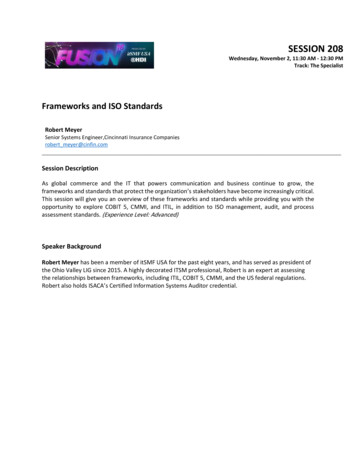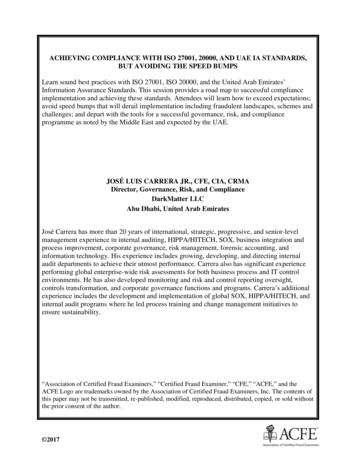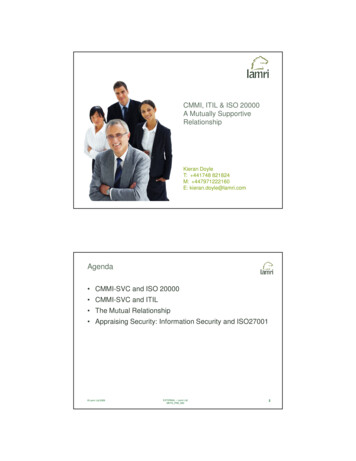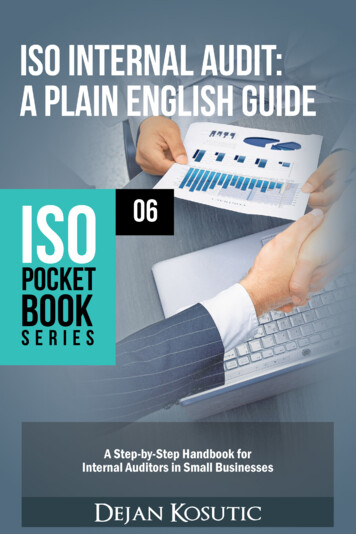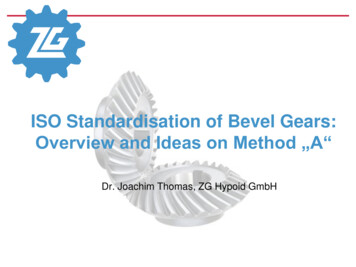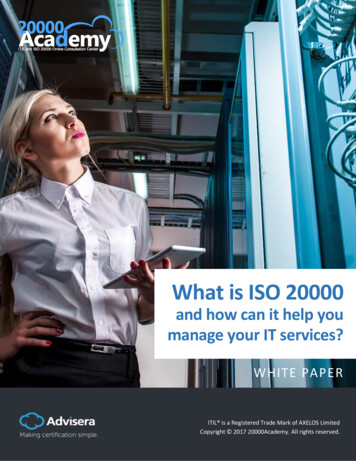
Transcription
What is ISO 20000and how can it help youmanage your IT services?WHITE PAPERITIL is a Registered Trade Mark of AXELOS LimitedCopyright 2017 20000Academy. All rights reserved.Copyright 2017 Advisera Expert Solutions Ltd. All rights reserved.1
Table of ContentsExecutive Summary.3The basics of ISO 20000 .4IT standard for the improvement of the business.5What does ISO 20000 actually look like?.6ISO 20000 and ITIL.9Getting to the heart of the benefits of ISO 20000 .11Common myths related to ISO 20000 implementation.13Implementation of ISO 20000.14How to become ISO 20000 certified.16Conclusion.20Useful resources.20References .20Copyright 2017 Advisera Expert Solutions Ltd. All rights reserved.2
Executive SummaryISO 20000 is the international standard for ITService Management (ITSM), published by ), and ICE (the InternationalElectrotechnical Commission).Due to the fact that IT services (with underlyingtechnological architecture and applicationlandscape) are increasing in complexity,organizations are striving to find a way to gaincontrol of implementation and delivery of theservices. Many of them found out that ISO 20000makes an excellent match – it encompasses thewhole lifecycle of the service(s), includesextensive guidelines (there are eight parts of theISO 20000 standard), and is process based.This white paper explains what the ISO 20000standard is and its purpose to establish theService Management System (SMS) by applyingPlan-Do-Check-Act (PDCA) methodology. Afterproviding more details about content andstructure, the white paper focuses on benefits ofthe ISO 20000 implementation and on, includes establishment of the SMSand implementation of all processes required bythe standard. For smaller organizations this cantake four to six months, and large organizationsneed much more time. Therefore, budget andresources must be well planned because theefficiency of the implementation has a directimpact on the organization itself, and theservices used by the organization’s customers.The first edition of ISO 20000 was published in2005, but, like some other ISOs, originated in aBritish Standard: BS 15000. In 2011, the existingrevision was published.Figure: Development of the ISO 20000 series of standardCopyright 2017 Advisera Expert Solutions Ltd. All rights reserved.3
The basics of ISO 20000The ISO 20000 standard describes methodology and a set of management processes designed toestablish, maintain and improve Service Management System (SMS) in order to help you deliver effectiveIT services (both within your business and to your customers). ISO 20000 gives you the methodology andthe framework to help you manage your ITSM, while allowing you to prove your company follows bestpractice. With the implementation of the standard’s requirements organizations use best practice whichhelp them to improve delivery of IT services. Written by leading experts in ITSM, ISO 20000 is applicableto any company size and any industry: big or small, for-profit or not-for-profit, private or government.As an auditable norm, the 2011 version of the standard has 256 hard requirements that have to be met.It provides a full set of processes a company HAS to implement if aims to obtain a certificate. A bit moreprecisely, the standard has two main parts: ISO 20000-1 “Service management system requirement” – requirements, what SHALL be doneISO 20000-2 “Guidance on the application of service management systems” – code of practice, aguide as to HOW it should be done in more detailBeside these two main parts, ISO 20000 at present has additional six parts: ISO 20000-3 “Guidance on scope definition and applicability of ISO 20000-1”ISO 20000-4 “Process reference model”ISO 20000-5 “Exemplar implementation plan for ISO 20000-1”ISO 20000-9 “Application of ISO 20000-1 to the cloud”ISO 20000-10 “Concepts and terminology for ISO 20000-1”ISO 20000-11 “Guidance on the relationship between ISO 20000-1 and related frameworks”Copyright 2017 Advisera Expert Solutions Ltd. All rights reserved.4
ISO 20000 is an IT standard, but it has hugeinfluence on your business as a whole. So, thequestion is – how is this possible? Here are fewtips:Improve your image and credibility – ISO 20000is the only internationally recognized standardfor IT service management. Its internationaladoption has been rapid in recent years, asorganizations see it as a key differentiator in themarketplace. And, as a popular and provenstandard, you can be sure of the efficacy andscalability of the processes.Gain a competitive advantage – Through moreeffective and efficient delivery of IT services, youcan give your organization tangible advantagesover your competitors. For example, you canreduce IT issues and respond to them faster,freeing up more of your time for strategic ITdevelopment in your organization.Increased customer satisfaction – Whether it’syour internal or external customers, you’re ableto deliver improved IT services that better meettheir needs – while at the same time betterprotecting the company, its assets, shareholdersand directors.Copyright 2017 20000Academy. All rights reserved.5
What does ISO 20000 actually look like?While consisting of eight parts, there are twothat are most used - ISO 20000-1:2011 and ISO20000-2:2012.ISO 20000-1:2011 is the formal specification forIT Service Management. It clearly defines all therequirements you need to deliver managed ITservices of an acceptable quality for yourcustomers. It includes:Service Management System requirements –Discuss basic requirements to establish the SMSby applying PDCA methodology to all parts of theSMS and the services. Crucial elements of theSMS setup are the SMS Policy and, particularly,the SMS Plan. The SMS Plan defines the scope,how to fulfill different kinds of requirements,responsibilities and resources needed to run theservices. Read the article “How to define thescope of the SMS in ISO 20000” to learn more.Design and transition of new or changedservices – This set of ISO 20000 requirements iscarefully derived from best practices, and g services in a ServiceManagement System. In practice, this chapterwill help the provider to tidy up the system andto engage parts of the company that may beoutside of the system scope (typicallydevelopment, finance, etc.) to provide therequired deliverables necessary for a smoothintroduction of services into the operation. Readthe article ”Design and transition of new orchanged services in ISO 20000” to learn more.Service delivery processes – This group ofprocesses is basic for managing delivery of IT. Bymanaging delivery of the services, anorganization directly influences customersatisfaction. To learn more about theseprocesses, read the article “ISO/IEC 20000Service Delivery processes – The basis for ITmanagement”Copyright 2017 Advisera Expert Solutions Ltd. All rights reserved.6
Relationship processes – This group ofprocesses offer the possibility to managesomething as complex as the relationship withcustomers and suppliers, which may involve, ifnot properly managed, loss of customers,prestige and money. To learn more, read thearticle “Taking care of relationships with ISO20000”Resolution processes – Since there are noservices that are faultless, this group of servicesenables fulfillment of contractual requirements(defined in Service Level Agreement – SLA)toward customers and manages any anomaliesthat may arise. Read the article “How to avoidunsatisfied customers by managing problemsand incidents according to ISO 20000”.Control processes – If an organization wants toimprove its services, it has to control them;otherwise, the situation will come dangerouslyclose to chaos. These processes help to controlthe configuration of the elements that make upthe service (servers, software, etc.), help controlchanges occurring in the service (change server,change of an agreement, etc.), and enablecontrol of deliveries that are sent to thecustomer. Read the article “Using ISO 20000 tocontrol IT services” to learn more.Figure: ISO 20000 structure (source: ISO/IEC 20000-1)Copyright 2017 Advisera Expert Solutions Ltd. All rights reserved.7
The second part: ISO 20000-2:2012 is the code of practice for IT service management; it is the guidanceof the application of Service Management Systems. In other words, it helps you to interpret therequirements of the standard. It defines the best practice management processes, and is very useful ifyou’re preparing to be audited against ISO 20000 or planning service improvements.It’s important to note your company can get certified against ISO 20000-1:2011, but not against ISO20000-2:2012 (this is a code of practice only).Copyright 2017 Advisera Expert Solutions Ltd. All rights reserved.8
ISO 20000 and ITILAlthough the ISO 20000 series of standardsincludes ISO 20000-2 (code of practice), it stilldoes not include any usable methodology forimplementation. ITIL makes for the perfect fit,i.e. provides best practice in ITSM.The basic difference between ISO 20000 and ITILis that ISO 20000 gives you the methodology andframework (providing you with the pieces withwhich to construct the ITSM jigsaw puzzle), whileITIL gives you the details (the best practices) onhow to manage each and every IT process in yourorganization (i.e. how to put the jigsaw puzzletogether).A good way to think of it is that ISO 20000 saysWHAT you need to do, while ITIL tells you HOWto do it.ISO 20000 does not work in complete isolation.It can be implemented independently from ITIL,but they do go very well together.As opposed to a standard, ITIL is a practicalframework of best practices that focuses onaligning your IT services with the wider needs ofyour business. As a company, you can’t becomeITIL certified; you can only comply with the bestpractice guidelines.ISO 20000 is based on the fundamentalprinciples of ITIL, and is a standard that yourcompany can certify against.Individuals seeking excellence in ITSM andinternationally recognized certification canbecome certified against ITIL and ISO 20000 (e.g.the foundation course discussed further below).ISO 20000 certification for organizations isessentially the evidence that best practices havebeen implemented. ITIL is not required to gaincertification in ISO 20000, but it is easier toachieve if you’re following an ITIL approach to ITservice management.Read this free whitepaper “ITIL vs. ISO/IEC20000: Similarities and Differences & ProcessMapping” to learn more about relation betweenITIL and ISO 20000.Copyright 2017 Advisera Expert Solutions Ltd. All rights reserved.9
Figure: ITSM pyramid which describe position of ISO 20000 and ITILCopyright 2017 Advisera Expert Solutions Ltd. All rights reserved.10
To understand the importance of ISO 20000, it’svital to understand the relationship between ITand the overall success of your organization. Youuse IT to overcome your competitors, to reachlarger audiences, to become more productiveand more efficient. In myriad ways, IT is vital toimproving revenues, reducing costs andenhancing your reputation.So, put simply, high-quality IT services andrelated IT service management standards arefundamental to your success. And gaining theISO 20000 standard is a way to ensure thatquality.Therefore, the benefits of ISO 20000 (as the onlyIT service management standard) cannot beoverstated; companies large and small haveused this standard to great effect, discoveringand securing tremendous cost and efficiencysavings. Here are just a few of these benefits:Become more productive – Gain a competitiveadvantage through increased efficiency andeffectiveness due to more reliable IT services.With everybody clear about who does what andwhen, you’ll reduce both the number ofincidents and your ability to handle them.Compliance – By your implementation of an ISOstandard, your customers know what theyshould expect; i.e., there are clear evaluationcriteria (e.g., by implementing ISO 20000 theyknow what to expect from the ChangeManagement or Incident Management process).Additionally, ISO 20000 takes care that legal orother regulations (e.g., security/ISO 27001) andtheir requirements are considered.Benchmark and improve – You can compareyour organization’s processes and activitiesagainst the international standard for ITSM (youcan then easily identify and implement anynecessary improvements). And, because anCopyright 2017 Advisera Expert Solutions Ltd. All rights reserved.11
independent certification body audits yourcompany, you (and anyone interacting with yourorganization) can be sure you’re meeting therequired level.Fully integrated processes – ISO 20000 helpsyou align IT services with the wider businessstrategy. You can ensure your company isfocused on the IT service management solutionsbest suited to serving your customers and theneeds of the business.Reduce the cost of IT – Better understand andmanage the cost of IT. Plan future financial costswith greater accuracy and clarity. With simplerprocesses and clear responsibilities, you canoperate a leaner, more efficient service.Create a culture of continual improvement –The business environment does not sit still,particularly in our age of digital andtechnological innovation. Ensuring yourorganization is always improving processes inreaction to customer feedback is not just a niceto-have; it’s essential for a company’s longevity.And this also extends to improvementsidentified internally, changing technology anddeveloping business norms.Become more agile and change quickly – ISO20000 creates the solid framework of bestpractice that helps support innovation. Changein your organization can be handled moreadeptly and with greater speed, meaning youreduce internal and external risk levels and aremore likely to meet your organizationalobjectives.To learn more, read the article “5 key benefits ofISO 20000 implementation”.Copyright 2017 Advisera Expert Solutions Ltd. All rights reserved.12
Common myths related toISO 20000 implementationImplementing a standard is not an everyday job.Therefore, it requires a lot of activities beforedecision for “Go/No-Go” is made. One of theactivities is to overcome myths related to ISO20000 implementation. Here are some of them:“ISO 20000 is only for big companies.” Simplyput, that’s not true. It could be implemented inorganizations of all sizes.“The implementation scope is huge and wedon’t have the resources for that.” Well, thereare many other possibilities that give you theopportunity to implement ISO 20000 in a smallercompany without many resources, e.g.,consultantsorusingtemplatesforimplementation (see ISO 20000 toolkit page)“We know our management; they are notinterested in such projects.” I’m sure they are,but you have to get them. Management like tohear about (and is interested in) productivityincreases, financial savings, or increasedcustomer satisfaction.“Tools to support the implementation are ahuge cost factor.” There are many free-ofcharge tools that can help you.Read the article “What are the most commonISO 20000 implementation myths?” to learnmore about myths related to ISO 20000implementation.Copyright 2017 Advisera Expert Solutions Ltd. All rights reserved.13
Implementation ofISO 20000Implementation of ISO 20000 can vary incomplexity depending on the maturity of theorganization itself, but also on alreadyimplemented processes. When starting fromscratch, here are the most importantimplementation steps:1. Initiation – here you will prepare theimplementation as a project and get ready topresent it. Use this free “Project Plan forImplementation of the Service ManagementSystem according to ISO/IEC 20000-1” tomanage your project.2. Obtain management support – in this phaseyou will present the project to yourmanagement and gain their approval. Use thisfree “Project proposal for ISO 20000-1:2011implementation” to help you in this step3. Select a certification body – here you will setthe criteria for your certification body, sendinquiries and do the selection4. Define the scope – this is critical step. Thescope is – where the ISO 20000 will be applied.Read the article “How to define the scope of theSMS in ISO 20000” to learn more.5. Assessment and gap analysis – see what is thedifference between what you have in your ITSMand what the standard requires? Use this “FreeISO 20000 Gap Analysis Tool” for the analysis.6. Process and SMS documentation – there area lot of required documents needed toimplement the SMS. Prepare templates andgenerate required documents. And don’t forgetto keep them understandable and usable.7. Training and awareness– once you are donewith preparation, you have to get everyoneinvolved in your SMS on the same level ofunderstanding and knowledge.8. Implement the SMS and processes – that’swhere the majority of work is performed. Ifpossible, use some of the ITSM tools to helpyourself(read this article to get moreCopyright 2017 Advisera Expert Solutions Ltd. All rights reserved.14
information on free tools: ”Free tools for ITSM –supporting IT Service Management for zero toolcost”).9. Implementation review – same as with anyother project, it’s recommendable to take a lookbackwards and see what was good or bad, whatcould be improved next time, etc. Read thisarticle to see how Project Management can help:“ITIL and ISO 20000 – What does ProjectManagement have to do with it?”10. Certification – and, this is the step where youwill see how good the implementation was.11. Continual Service Improvement – once youare done, you will continually work on your SMS.Sometimes because you see what could be donebetter and sometimes business i.e. customertriggers improvements.Use ISO 20000 Implementation Project ChecklistandDiagram of ISO ntation project.Copyright 2017 Advisera Expert Solutions Ltd. All rights reserved.15
How to becomeISO 20000 certifiedThere are two types of ISO 20000 certifications: for companies and for individuals.If your organization wants to become certified, you need to be formally assessed by an accreditedcertification body. You will need to demonstrate the quality of your company’s IT processes against theISO 20000-1 standard. Individuals, on the other hand, can become certified by passing exams (see belowfor further details).But, merely creating ITSM process documentation is not enough (and will not solve your problems). Toensure certification, you have to integrate all the activities described in your documentation into yourday-to-day business.And, most importantly, you have to gain value. There is little point in creating the documentation andmaking all these changes if, at the end, your company has not realized the real-world value possible fromISO 20000. Otherwise, people within your organization will rightly question why you’re bothering.Mandatory steps for finishing implementation and gettingcertifiedFor an organization to obtain the ISO/IEC 20000 certification, it has to engage the services of a certificationbody. What is a certification body? That’s a company that is responsible for issuing certificates tocompanies that request their services and comply with the requirements of the standard against whichthey want to become certified. Examples of certification bodies are: Bureau Veritas, BSI, SGS, etc.Copyright 2017 Advisera Expert Solutions Ltd. All rights reserved.16
The certification bodies must also comply with rules and requirements of another ISO standard – ISO17021, and also must be audited and accredited by government entities that are known as accreditationbodies.Each country has an accreditation body that is responsible for auditing certification bodies to ensure theymeet the requirements of the reference standard.StagesLet s look at the steps that are necessary in the process of ISO/IEC 20000 certification, following theguidelines set in ISO 17021:1. Request: The company that wants to certify against ISO/IEC 20000 requests a proposal. The requestmust contain information about the company: number of people involved in the scope, main lines ofbusiness, scope, etc. Based on this information, the certification body calculates the number of daysrequired, and depending on the number of days, sets the price of the proposal. Finally, the certificationbody sends the proposal to the company.2. Certification Audit: If the company approves the ISO/IEC 20000 certification proposal, it then carriesout the certification audit. This audit is basically composed of two stages:Stage 1: The audit team prepares an Audit Plan, which must contain all issues to be reviewed at this stage.It will also identify persons who will interview, and date and time of all activities to be undertaken duringthe audit. The activities carried out in this stage are basically the review of documentation generated bythe company, i.e. mainly procedures, technical instructions, etc., and everything related to theManagement System (PDCA). Also, the company will plan dates and activities that will take place in thenext stage, stage 2. As a result of stage 1, the audit team will develop and deliver an audit report to thecompany, which reflects all the detected deviations. So, the purpose of the stage 1 audit, also calledDocumentation Review, is to check whether the documentation is compliant with ISO 20000.Stage 2: As in stage 1, the audit team will prepare an Audit Program for this stage, which will contain allthe things to do and all the people involved. In this second stage the audit team will review everythingthat has been pending management system and PDCA operational implementation of all ISO/ 20000processes. As a result of this stage, an Audit Report is generated, which will contain all deviations fromstage 2, plus the deviations that have not been treated in stage 1. Therefore, we can say that this reportwill be the final report of the certification audit. So, the purpose of the stage 2 audit, also called the MainAudit, is to check whether the activities and processes in a company are compliant with the standard andwith the documentation. In other words, to check whether the SMS works.These two stages are needed only in the first certification audit, and therefore are not present in thesurveillance audits and audits of recertification.Copyright 2017 Advisera Expert Solutions Ltd. All rights reserved.17
3. Obtaining the Certificate: If the company addresses all deviations of the report presented by the auditteam and presents the necessary evidence to the certification body, the certification body then releasesthe Report, and finally approves the granting of the certificate to the company. In most cases thecertificate is granted, but sometimes may be rejected, due to the immaturity of the system.4. Surveillance Visits: An ISO certificate is valid for three years, during which time surveillance visits areconducted. That is, after the first certification audit, in the next two years the company will have to facefurther audits.5. Recertification Audit: Finally, after three years, when the certificate expires, the company will have toface a recertification audit to maintain the certificate.RequestCertificationAuditObtaining itFigure: Gaining and maintaining ISO 20000 certificate for organizationsCopyright 2017 Advisera Expert Solutions Ltd. All rights reserved.18
How do you get an ISO 20000 certificate if you’re anindividual?If you are an individual, you can get certified inISO 20000 if you pass, for example, the ISO20000 Lead Auditor Course or ISO 20000 LeadImplementer Course. Many employers are keento support this training, as qualified ISO 20000practitioners are a great way to help anorganization implement ISO 20000 (as well asbeing a valuable transferrable skill to include ona resume).There is a range of course options for individualsto choose from:ISO 20000 Foundation Certificate – If you’re lessfamiliar with ISO 20000, this is the course foryou. You will gain an understanding of thecontent and requirements of the standard. Inaddition, you will be more able to assess therelevance of ISO 20000 to the specific IT servicemanagement activities within your organization.ISO 20000 Lead Auditor Course – This is a veryuseful course for professionals implementingISO 20000, because it gives you an excellentoverview of the standard and provides in-depthexplanations of what the certification auditorswill ask for at the certification audit. Therefore,it is useful for auditors and implementers. It lastsfor five days and finishes with a written exam.ISO 20000 Lead Implementer Course – Thiscourse is similar to the lead auditor course,except it focuses on implementation techniquesrather than auditing ones. So, if certification isnot your concern, this course may be moresuitable.ISO 20000 Internal Auditor Course – This courseis a “light” version of the Lead Auditor Course,lasting about two or three days. With thiscondensed course, you would be unable topursue a career as an auditor in a certificationbody. But, if you want a systematic introductionto ISO 20000 or you plan to be the internalauditor in your company, this course is perfectfor you.There are a number of accredited trainingorganizations around the world where you cangain individual qualifications in ISO 20000.Copyright 2017 Advisera Expert Solutions Ltd. All rights reserved.19
ConclusionAlthough ISO 20000 implementation seems complex, the benefits that certified organization achieve aresignificant. An SMS affects services, and therefore customers and users, directly. Well-managed serviceswill be appreciated by customers, and their feedback will be beneficial for the organization (and,particularly, the organization’s management). Continual improvement is a guarantee that, onceimplemented, the SMS increases the quality of delivered services and responds to the changing businessenvironment efficiently.Useful resourcesThese online materials will help you with ISO 20000 implementation: Preparations for the ISO Implementation Project: A Plain English Guide – short handbookcontaining expert guidance on preparation for ISO implementation. Managing ISO Documentation: A Plain English Guide – short handbook containing expertguidance on handling ISO documents.ReferencesISO Organization: http://www.iso.org/20000Academy: http://www.advisera.com/20000academy/Copyright 2017 Advisera Expert Solutions Ltd. All rights reserved.20
Advisera Expert Solutions Ltdfor electronic business and business consultingZavizanska 12, 10000 ZagrebCroatia, European UnionEmail: support@advisera.comU.S. (international): 1 (646) 759 9933United Kingdom (international): 44 1502 449001Toll-Free (U.S. and Canada): 1-888-553-2256Toll-Free (United Kingdom): 0800 808 5485Australia: 61 3 4000 0020Copyright 2017 Advisera Expert Solutions Ltd. All rights reserved.21
ISO 20000-2 “Guidance on the application of service management systems” –code of practice, a guide as to HOW it should be done in more detail Beside these two main parts, ISO 20000 at present has additional six parts: ISO 20000-3 “Guidance on


